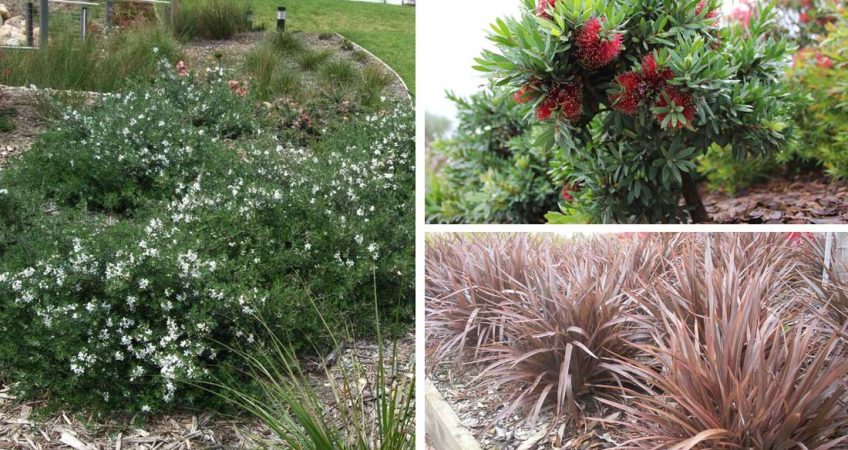Introduction
Have you ever wondered how to achieve a harmonious and visually impactful garden with minimal maintenance? In this article, we’ll delve into the concept of mass planting, exploring its definition and providing expert advice on designing effective mass planting schemes.
Whether you are an experienced home gardener, landscape architect, designer, or a council decision-maker, understanding mass planting can revolutionise your approach to landscape design.
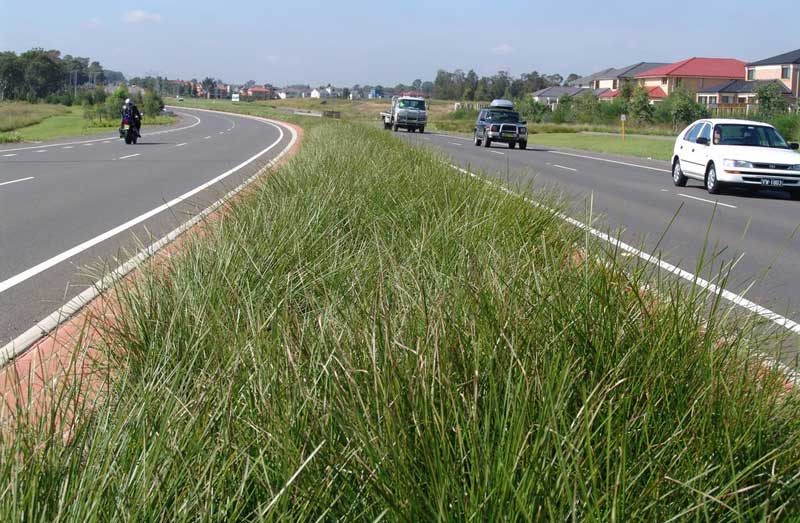
Mass planting is simply planting the same variety over and again in a single bed. Tanika Lomandra is a low-maintenance, evergreen strappy plant that controls erosion, so it’s perfect for this roadside bed.
What is Mass Planting?
Definition and Key Concepts
Mass planting involves the use of large quantities of the same plant species or cultivar in a designated area. The aim is to create a cohesive and striking visual effect through uniformity and repetition.
The benefits of mass planting are numerous. It offers aesthetic appeal by creating a harmonious visual impact that’s achieved through repetition. On top of this, it simplifies maintenance routines as there are fewer different species to care for. Mass planting also enhances biodiversity by supporting local wildlife with consistent habitats and is particularly practical for large areas and public spaces where a cohesive look is desired.
Mass planting beds can add interest when multiple species are mass planting nearby for contrast. You can contrast foliage and flower colours, textures, shapes and sizes between different mass-planted beds.
Designing a Mass Planting Scheme
Planning Your Design
The first step in designing a mass planting scheme is thorough site analysis. This includes assessing the soil type, pH levels, and drainage capabilities. It’s also important to evaluate the site’s exposure to sunlight and shade throughout the day, understanding common pests/diseases in the area, and considering any microclimates that may exist.
Choosing the right plants for the right places is a fundamental part of good landscape design. Select species that are well-suited to the specific soil and climatic conditions of your site. Consider the growth habits and mature size of plants to ensure they fit well within the design without causing overcrowding. Factor in plant functions you wish to benefit from, including biodiversity support, visual interest, controlling erosion, and so forth.
Aesthetic Considerations
Colour schemes should be carefully considered to enhance the visual impact of mass plantings. Monochromatic schemes use various shades of a single colour to create a serene and cohesive look. Analogous schemes employ colours that are adjacent on the colour wheel for a harmonious blend, while complementary schemes use colours opposite each other on the colour wheel to introduce vibrant contrast.
Texture and form are also important to consider. Mixing fine-textured plants with bold, coarse-textured species adds depth and interest to the garden. Combining different plant forms—such as upright, mounding, and spreading—creates a dynamic yet balanced composition.
Once multiple species are interspersed together in the same bed, it stops being a “mass planting” bed. However, different species mass planted nearby each other can achieve the effects we’ve just discussed.
Best Plants for Mass Planting
Now that you understand the basics of mass planting, you need a list of plants to use. We’re focusing on plant genera, but remember that individual species and cultivars can perform differently than other plants within the same genus. Always read plant labels or online information before specifying and purchasing plants to make sure they suit the landscape conditions.
Westringia
Westringia species are excellent choices for mass planting beds, particularly the compact and ground-cover varieties. Known for their resilience and adaptability, most westringias prefer free-draining soils with some varieties able to tolerate heavier soils. Their dense, fine foliage and abundant small flowers create a soft, uniform appearance that is visually appealing. Additionally, westringias’ low maintenance requirements and drought tolerance make them ideal for sustainable gardens.
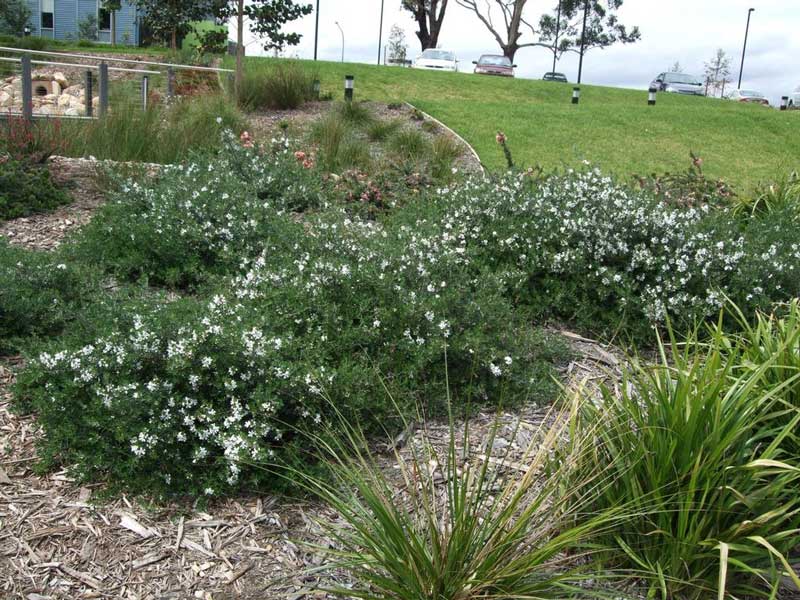
Mundi™ Westringia fruticosa ‘WES05’ PVR. https://ozbreed.co.nz/plant-ranges/shrubs-and-ground-covers/mundi-westringia/
Callistemon
Compact varieties of callistemon, commonly known as bottlebrush plants, are well-suited for mass planting due to their striking appearance and robustness. These plants feature vibrant, bottlebrush-like flower spikes that attract pollinators, adding both colour and ecological value to the garden. Compact callistemons are hardy and can often tolerate a range of soil conditions, including poor and sandy soils. Their ability to thrive with minimal care makes them a practical choice for large-scale plantings.
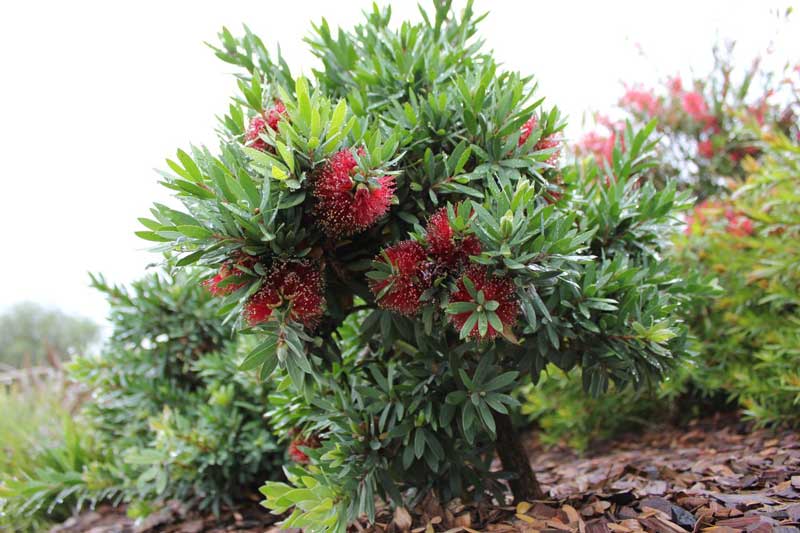
Better John™ Callistemon viminalis ‘LJ1’ PVR. https://ozbreed.co.nz/plant-ranges/shrubs-and-ground-covers/better-john-callistemon/
Nandina
Nandina, often referred to as heavenly bamboo, is an exceptional plant for mass planting beds. It provides year-round interest with its colourful foliage, which ranges from green to purple to red, and its clusters of bright red berries. Nandina is highly adaptable, tolerating both sun and part shade, and it thrives in a variety of soil types. Its low maintenance and moderate growth rate make it a popular choice for creating lush, vibrant planting schemes that require minimal intervention.
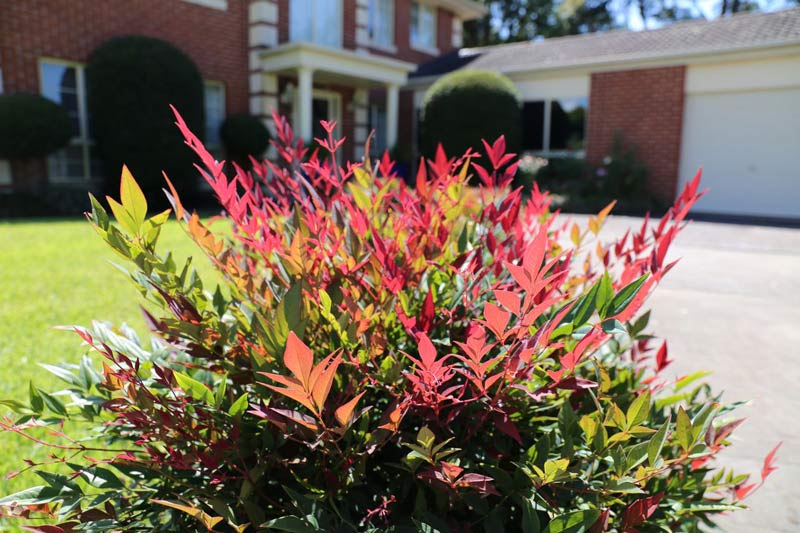
Obsession™ Nandina domestica ‘SEIKA’ PVR. https://ozbreed.co.nz/plant-ranges/shrubs-and-ground-covers/obsession-nandina/
Alternanthera
Alternanthera varieties offer a striking addition to mass planting beds with their vivid foliage colours, ranging from deep purples to bright greens and reds. These low-growing plants form a dense mat that effectively suppresses weeds and provides a continual burst of colour throughout the growing season. Alternantheras are relatively easy to maintain and thrive in well-drained soils, making them a fantastic option for creating visually dynamic and low-maintenance garden spaces.
5. Little Ruby™ Alternanthera dentata ‘LRU30’ PVR. https://ozbreed.co.nz/plant-ranges/other-plants/little-ruby-alternanthera/
Phormium
Phormium species, commonly known as New Zealand flax, are outstanding choices for mass planting due to their striking architectural form and colourful foliage. These plants feature long, sword-like leaves that come in a range of colours, from deep green to bronze and variegated patterns. Phormiums are incredibly hardy, tolerating wind, salt spray, and poor soils, making them ideal for coastal and exposed sites. Their minimal maintenance requirements and bold visual impact make them a favourite for creating dramatic and sustainable planting designs. The smaller varieties are particularly suited for mass planting.
6. Sweet Mist™ Phormium tenax ‘PHOS2’ PVR. https://ozbreed.co.nz/plant-ranges/strappy-leaf-plants/sweet-mist-phormium/
Dianella
Dianella, commonly known as Australian flax lilies, are ideal for mass planting due to their hardy nature and attractive, strap-like foliage. These plants produce charming blue or purple flowers followed by decorative blue/purple berries, adding both colour and texture to garden beds. Dianella species are drought-tolerant and can thrive in a range of soil conditions, including poor soils. Their low maintenance needs and ability to form dense clumps make them a practical and aesthetically pleasing choice for large-scale plantings.
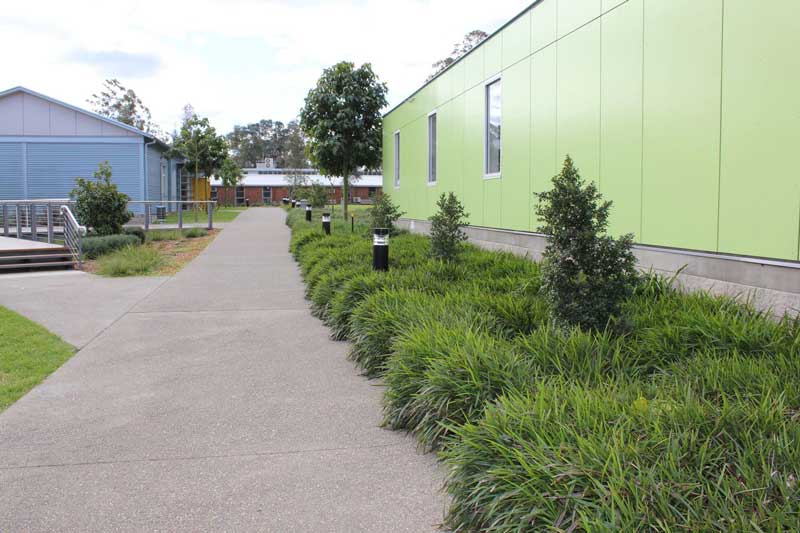
Little Jess™ Dianella caerulea ‘DCMP01’ PVR. https://ozbreed.co.nz/plant-ranges/strappy-leaf-plants/little-jess-dianella/
Lomandra
Lomandra species are celebrated for their tough, grass-like appearance and resilience, making them perfect for mass planting beds. These plants are highly tolerant of drought, poor soils, and varying light conditions, which allows them to thrive in challenging environments. Lomandras provide year-round structure with their evergreen foliage and occasional spikes of small flowers. Their ability to form dense, low-maintenance clumps contributes to their popularity in sustainable and aesthetically consistent garden designs.
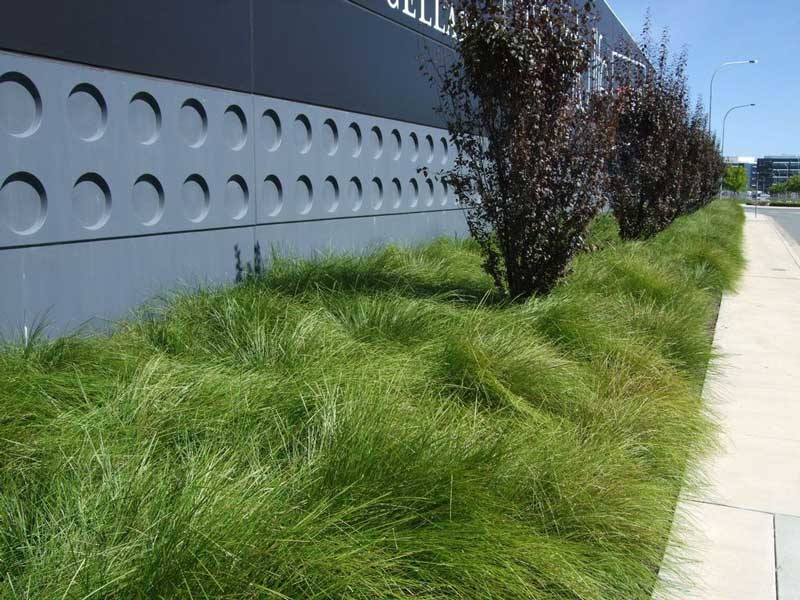
Tanika™ Lomandra longifolia ‘LM300’ PVR. https://ozbreed.co.nz/plant-ranges/strappy-leaf-plants/tanika-lomandra/
Liriope
Liriope, also known as lilyturf, is a versatile and durable plant that excels in mass planting applications. Its grass-like strappy foliage and upright flower clusters add texture and colour to garden beds. Liriopes are highly adaptable, thriving in both sun and shade, and they can tolerate a variety of soil conditions. They are particularly valued for their ability to establish dense, weed-suppressing mats, making them a practical solution for ground cover in large planting schemes.
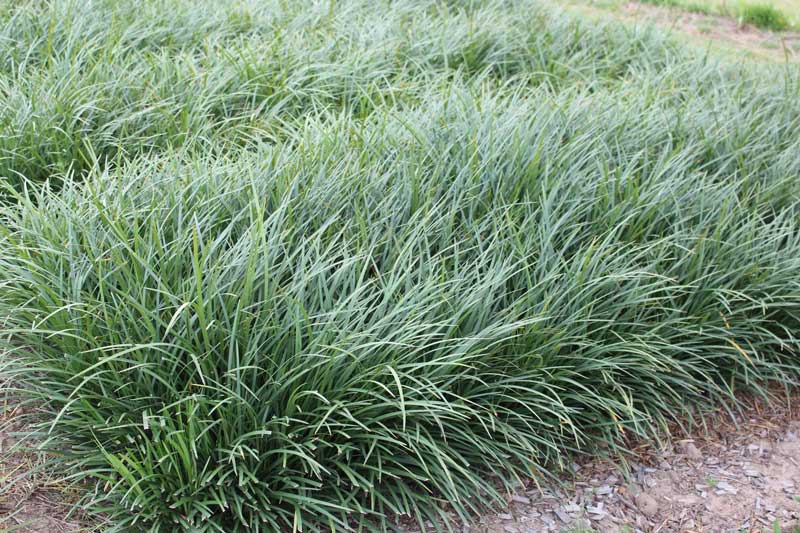
Just Right™ Liriope muscari. https://ozbreed.co.nz/plant-ranges/strappy-leaf-plants/just-right-liriope/
Practical Tips for Implementation
Site Preparation
Effective site preparation is important for the success of any mass planting scheme. Start with soil preparation by testing the soil to determine its texture and pH level. Amend the soil with organic matter, kaolin clay, and/or water crystals as needed to improve its structure and fertility. Ensure the site has proper drainage to prevent waterlogging.
Weed control is another critical step. Remove existing weeds thoroughly and implement preventive measures. Using chunky mulch can help suppress weed growth and retain soil moisture. As the mass planting beds establish, they will naturally suppress weeds to some degree, depending on the weed-suppressing characteristics of the specific plants chosen.
Plants with dense foliage and robust root systems tend to crowd out weeds better than plants with sparse foliage and less robust root systems.
Planting Techniques
When planting, adhere to the recommended spacing guidelines for each species to ensure that plants have enough room to grow to their mature size without overcrowding. This not only promotes healthy growth but also enhances the overall aesthetic appeal.
You can till the whole bed prior to planting, or dig individual holes for each plant. First, set up the pots on top of the ground to see where each plant will be installed. Dig a hole twice as wide and equally as deep as the root ball, tease the roots (if needed) and place in the hole. Add organic matter to the back fill, fill in the hole, firmly press down to remove air pockets (without compacting the soil), water well, and then mulch without crowding the plant’s above-ground parts.
Remember, we want stems and leaves in the air, and roots in the ground.
Watering and mulching play significant roles in plant health. Implement efficient irrigation systems to provide consistent moisture or choose drought-tolerant plants that can survive on variable rainfall. Applying mulch helps retain soil moisture, regulate temperature, and further suppress weeds.
Maintenance of Mass Planting
Routine Care
Routine care is necessary to maintain the health and appearance of a mass planting scheme. Establish a watering schedule based on the specific needs of your plants, adjusting it according to seasonal variations and rainfall. Reticulated irrigation is needed in public landscapes where hand-watering isn’t feasible
Use slow-release fertilisers to provide a steady supply of nutrients and promote healthy growth. Organic fertilisers like compost, manure, worm castings, etc. improve the soil quality while also feeding plants.
Regular pruning and thinning helps plants maintain their shape and encourage new growth. Over-planting can help gardens look good immediately after landscaping, and thinning out every second plant as plants grow can prevent overcrowding and ensure adequate air circulation to reduce the risk of disease.
Long-Term Sustainability
For long-term sustainability, incorporate Integrated Pest Management (IPM) practices into your routine care. Monitor plants regularly for signs of pests and diseases, and use non-chemical control methods where possible. These include genetic, cultural, physical, and biological methods, which are more environmentally friendly and sustainable in the long run.
Seasonal adjustments are necessary to adapt to changing conditions. Prepare for seasonal changes by adjusting watering and care routines accordingly. Replace annuals and perennials as needed to maintain the desired appearance and health of your mass-planted beds.
Conclusion
Mass planting offers numerous benefits, including aesthetic appeal, low maintenance, enhanced biodiversity, and practical solutions for large areas. By carefully planning your design, choosing appropriate plants, and implementing effective site preparation and planting techniques, you can create a beautiful and sustainable garden.

